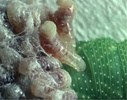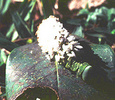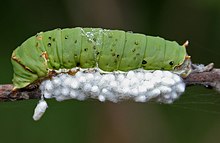You are here
Taxonomy
Braconidae
EOL Text
Keys to the world subfamilies and general introductions to the literature are available in van Achterberg (1993) and Sharkey (1993). A new manual to the genera of the New World has been produced (Wharton et al., 1997 - Spanish version 1998), including individual subfamily chapters contributed by a number of the world's braconid specialists. Interactive versions of the keys in this manual are available online. van Achterberg (1997) has published the CD-ROM Braconidae. An illustrated Key to all Subfamilies.
The higher classification of the Braconidae has been a matter of much dispute. Approximately 40 subfamilies are generally recognized, several of them newly discovered within the last 15 years (Mason, 1983; Quicke, 1987; Whitfield and Mason, 1994). Several subfamilies (e.g., Aphidiinae, Alysiinae, Apozyginae) have at one time or another been recognized as separate families. In general there is agreement on the basic subfamily or tribal groupings, with the exception of the "hormiine" and "exothecine" groups of genera (Whitfield, 1992; Quicke, 1993; Wharton, 1993b), but disagreement on the ranking or inclusiveness of some groups, since our understanding of the phylogeny of the family is not yet robust. There is a general perception that the number of recognized subfamilies has become inflated, while the tribal rank has been underutilized. An attempt has been made to address this problem (Wharton, 2001), but requires further phylogenetic testing.
The vast majority of braconids are primary parasitoids of other insects, especially upon the larval stages of Coleoptera, Diptera, and Lepidoptera but also including some hemimetabolus insects (aphids, Heteroptera, Embiidina). As parasitoids they almost invariably kill their hosts, although a few only cause their hosts to become sterile and less active. Both external and internal parasitoids are common in the family, and the latter forms often display elaborate physiological adaptations for enhancement of larval survival within host insects, including the co-option of endosymbiotic viruses for compromising host immune defenses (Stoltz and Vinson, 1979; Stoltz, 1986; Whitfield, 1990; Beckage, 1993, Stoltz and Whitfield, 1992; Whitfield, 2002; Whitfield and Asgari, 2003).
Early larval development in braconids has also yielded surprises, such as the discovery of relatively closely related genera that differ in such import aspects as syncitial versus holoblastic cleavage, normally characterizing major animal phyla (Grbic and Strand, 1998; Grbic, 2000)! Parasitism of adult insects (especially of Hemiptera and Coleoptera) is also known, and members of two subfamilies (Mesostoinae and Doryctinae) form galls on plants (Infante et al., 1995; Austin and Dangerfield, 1998). Several excellent general reviews of braconid biology are available (Matthews, 1974; Shaw and Huddleston, 1991; Shaw, 1995; Wharton, 1993a).
Figure 6. Microplitis ceratomiae larvae emerging from sphingid caterpillar.
Image copyright © 2004 James B. Whitfield
Figure 7. Sphingid caterpillar with cocoons of Cotesia congregata.
Image copyright © 2004 Sydney A. Cameron
Animal / parasitoid / endoparasitoid
larva of Perilampus tristis is endoparasitoid of cocoon of Braconidae
| License | http://creativecommons.org/licenses/by-nc-sa/3.0/ |
| Rights holder/Author | BioImages, BioImages - the Virtual Fieldguide (UK) |
| Source | http://www.bioimages.org.uk/html/Braconidae.htm |
Early attempts to explore the phylogeny of the major groups of Braconidae (e. g., Tobias, 1967; van Achterberg, 1984) were largely intuitive. Quicke and van Achterberg (1990) made the first large-scale effort to estimate braconid phylogeny using a large data set of morphological characters, and computer-assisted parsimony analysis. Although many aspects of this study have been in dispute (Wharton et al., 1992; van Achterberg and Quicke, 1992), it has stimulated a number of further attempts at resolving the phylogeny of subset groups of the Braconidae, using morphology as well as molecular data (e. g. Belshaw and Quicke, 1997; Whitfield, 1997; Belshaw et al., 1998; Dangerfield et al., 1999; Dowton et al., 1998; Dowton, 1999; Mardulyn and Whitfield, 1999; Quicke and Belshaw, 1999; Quicke et al., 1999; Belshaw et al., 2000; Kambhampati et al., 2000; Sanchis et al., 2000; Belshaw et al., 2001; Dowton et al., 2002; Whitfield et al., 2002; Chen et al. 2003).
The phylogeny used as the backbone here for accessing the subfamilies is adapted and pasted together, with a great deal of conservative poetic license, from these recent studies. It should not be taken all that seriously, as help is on the way in the form of continuing morphological and molecular phylogenetic studies. The reader is encouraged to consult the literature cited above for more in-depth analysis.
Barcode of Life Data Systems (BOLD) Stats
Specimen Records:71283
Specimens with Sequences:62702
Specimens with Barcodes:55858
Species:4987
Species With Barcodes:4380
Public Records:36171
Public Species:3151
Public BINs:5839
Collection Sites: world map showing specimen collection locations for Braconidae![]()
Braconidae is a family of parasitoid wasps and one of the richest families of insects. Between 50,000 and 150,000 species exist worldwide. The species are grouped into about 45 subfamilies and 1,000 genera, some important ones being: Ademon, Aphanta, Asobara, Bracon hebetor, Cenocoelius, Chaenusa, Chorebidea, Chorebidella, Chorebus, Cotesia, Dacnusa, Microgaster, Opius, Parapanteles, Phaenocarpa, Psenobolus.
Contents |
//
Morphology
The morphological variation among braconids is notable. Braconids are often black-brown (sometimes with reddish markings), though some species exhibit striking coloration and pattern, being parts of Müllerian mimicry complexes. They have one or no recurrent veins, unlike other members of the Ichneumonoidea which usually have two. Wing venation patterns are also divergent to apparent randomness. The antennae have 16 segments or more; the hind trochanters have 2 segments.
Females often have long ovipositors, an organ that largely varies intraspecifically. This variation is closely related to the host species upon which the wasp deposits its egg. Species that parasitize microlepidoptera, for instance, have longer ovipositors, presumably to reach the caterpillar through layers of plant tissue. Some wasps also have long ovipositors because of caterpillar defense mechanisms such as spines or hairs.
Parasitism
Most braconids are primary parasitoids (both external and internal) on other insects, especially upon the larval stages of Coleoptera, Diptera, and Lepidoptera, but also some hemimetabolous insects like aphids, Heteroptera or Embiidina. Most species kill their hosts, though some cause the hosts to become sterile and less active. Endoparasitoid species often display elaborate physiological adaptations to enhance larval survival within host, such as the co-option of endosymbiotic viruses for compromising host immune defenses. These polydnaviruses are often used by the wasps instead of a venom cocktail. The DNA of the wasp actually contains portions that are the templates for the components of the viral particles and they are assembled in an organ in the female's abdomen known as the calyx.[1] A 2009 study has traced the origins of these templates to a 100-million-year-old viral infection whose alterations to its host DNA provided the necessary basis for these virus-like "templates".[2]
These viruses suppress the immune system and allow the parasitoid to grow inside the host undetected. The exact function and evolutionary history of these viruses are unknown. It is a little surprising to consider that sequences of polydnavirus genes show the possibility that venom-like proteins are expressed inside the host caterpillar. It appears that through evolutionary history the wasps have so highly modified these viruses that they appear unlike any other known viruses today. Because of this highly modified system of host immunosuppression it is not surprising that there is a high level of parasitoid-host specificity. It is this specificity that makes Braconids a very powerful and important biological control agent.
Parasitism on adult insects (particularly on Hemiptera and Coleoptera) is also observed. Members of two subfamilies (Mesostoinae and Doryctinae) are known to form galls on plants.

Exploitation of ant-aphid mutualism by unidentified parasitic wasp: wasp laying eggs in aphid undisturbed by investigating ant.
Larval development
Surprisingly, both syncitial and holoblastic cleavage are present, even in closely related taxa.
Larvae can be found on hosts as diverse as aphids, bark beetles, and foliage-feeding caterpillars. Many species are egg-larval parasitoids; hence they are often utilized as biological pest control agents, especially against aphids.
Natural history
The family seems to date from early Cretaceous (provided that Eobracon is properly assigned to this family). It underwent extensive diversification from mid or late Cretaceous to early Tertiary, correlating with the radiation of flowering plants and associated herbivores, the main hosts of braconids.
Classification
Braconidae is traditionally divided into more than 40 subfamilies. These fall to two major groups, informally called the cyclostomes and non-cyclostomes. In cyclostome braconids, the labrum and the lower part of the clypeus are concave with respect to the upper clypeus and the dorsal margin of the mandibles. These groups may be clades that diverged early in the evolution of braconids.[3]
Other characteristics
The species Microplitis croceipes possesses an extremely accurate sense of smell and can be trained for use in narcotics and explosives detection[4].
References
- ^ Piper, Ross (2007), Extraordinary Animals: An Encyclopedia of Curious and Unusual Animals, Greenwood Press.
- ^ Drezen, Jean-Michel; Lanzrein, Beatrice; Volkoff, Anne-Nathalie; Huguet, Elisabeth; Dupuy, Catherine; Periquet, Georges; Pfister-Wilhem, Rita; Belghazi, Maya; Heller, Manfred; Roditi, Isabel; Wincker, Patrick; Bernard-Samain, Sylvie; Gyapay, Gabor; Wetterwald, Christoph; Herbinière, Juline; Annaheim, Marc; Bézier, Annie (February 13, 2009). "Polydnaviruses of Braconid Wasps Derive from an Ancestral Nudivirus". Science (Science Magazine) 323 (5916): 926–930. doi:10.1126/science.1166788. PMID 19213916. http://www.sciencemag.org/cgi/content/abstract/323/5916/926. Retrieved 2009-02-13.
- ^ Wharton, Robert M. (2000), "Can braconid classification be restructured to facilitate portrayal of relationships?", in Austin, Andrew D.; Dowton, Mark, Hymenoptera: evolution, biodiversity, and biological control, 4th International Hymenopterists Conference, Collingwood, Victoria, Australia: Commonwealth Scientific and Industrial Research Organisation (CSIRO), pp. 143–153, ISBN 0 643 06610 1
- ^ The Scoop: Move Over, Rover. November 20, 2001
| License | http://creativecommons.org/licenses/by-sa/3.0/ |
| Rights holder/Author | Wikipedia |
| Source | http://en.wikipedia.org/w/index.php?title=Braconidae&oldid=405460224 |
Barcode of Life Data Systems (BOLDS) Stats
Public Records: 0
Specimens with Barcodes: 1
Species With Barcodes: 1





